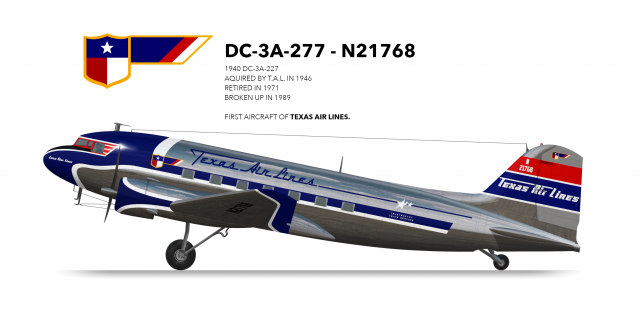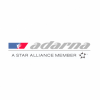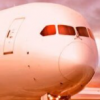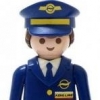
2. Texas Air Lines DC-3A "1946-1955"
- Owner: Bradimir (View all images and albums)
- Uploaded: Sep 03 2021 05:06 PM
- Views: 1,316
- Album Texas Air Lines
Boomeruesky

After World War II, the State of Texas was committed to improving its infrastructure and transportation. Realizing the advantages of air travel, Texas Air Lines was chartered to expand the reach of the growing air mail service, and provide a passenger connections from the large cities in the east to El Paso, and the towns, settlements, ranches, and military camps in-between. Dubbed the "official airline of Texas," TAL began on April 10th, 1946, with 4 airplanes, all second hand.
In a ceremony in front of the Houston Air Terminal, Mayor Otis Massey and Governor Coke Stevenson stepped aboard the first "Lone Star Liner," a 1940 Douglas DC-3A, for a flight around the city and along the Texas coastline, before returning to the field for a small, but well covered reception, with media from all over the state being present. That same afternoon, N-21768 would depart Houston bound for El Paso, with stops in Austin, San Angelo, Midland, and Van Horn before arriving in El Paso that evening. The aircraft would make the return trip the next day, skipping the stops in Van Horn and Midland, but adding one in Victoria before returning to Houston. Another aircraft would depart Houston on the 11th, arriving in Amarillo that afternoon with stops in Waco, Dallas and Wichita Falls, before returning to Houston that evening. With the initial flights complete, the airline's "Trans-Texas" route system was born.
After World War II, the State of Texas was committed to improving its infrastructure and transportation. Texas Air Lines was chartered to expand the reach of the growing air mail service, and provide a passenger connections from the large cities in the east, to El Paso, and the towns, settlements, ranches, and military camps in-between. Dubbed the "official airline of Texas," TAL began that April day with 4 airplanes, all second hand.
The Douglas DC-3 would serve until 1960, flying regional routes across the state to rural locations where non-paved fields in central and west Texas were common. When the arrival of newer jets allowed for them to be phased out, all of them were sold. At the peak of the fleet, TAL would operate 10 DC-3s, supplementing the faster Convair 240s, 340s and 440s used in mainline service.
This is the second of several posts dedicated to "the airplane that taught man how to fly." I am planning at least one more, possibly a fourth.

 Sign In
Sign In Create Account
Create Account














Gorgeous, I can see it being a showpiece of some smaller aviation museum today